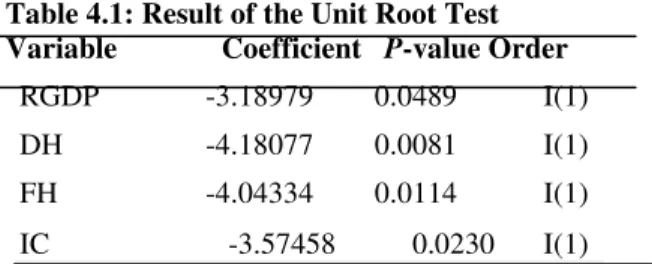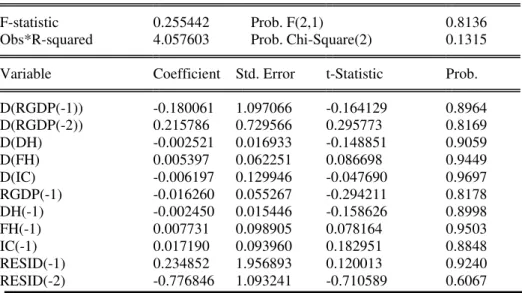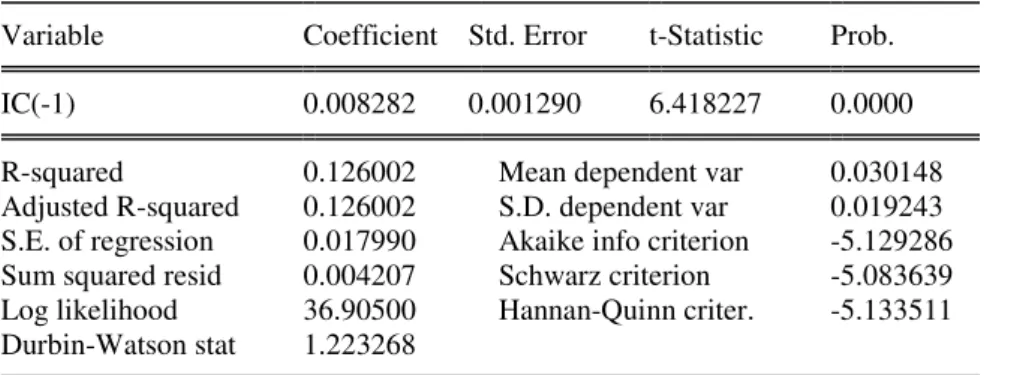Do Non-Bank Financial Institutions’ Loans and Advances
Influence Economic Growth? A Bounds Test Investigation
A.E. Osuala (PhD) and Odunze, C.O. Department of Banking and Finance
Michael Okpara University of Agriculture, Umudike Umuahia Abia State. Abstract
The study examines the economic impact of non-bank financial institutions’ (NBFIs) loans and advances on Nigeria’s economic growth using Bounds testing approach to co-integration. Time series data covering the period 1996-2010 was used. Economic growth, proxied by real gross domestic product (RGDP) was regressed on loans and advances of Discount Houses (DH), Finance Houses (FH) and Insurance companies (IC) which were considered the important non-bank financial institutions in Nigeria. The result of the analysis shows that there is a long-run relationship between economic growth and loans and advances of insurance companies in Nigeria. The test further confirms the non-existence of any significant statistical relationship between economic growth and the loans and advances of Finance houses and Discount houses in Nigeria during the period studied. The empirical evidence emerging from the study suggests that non-bank financial institutions, especially insurance companies, are very important in the Nigeria’s financial system and as such should be harnessed so as to effectively channel long-term investment funds from the surplus unit of the economy to the deficit unit through them. This can be achieved through formulation of proper, prudent and investment-friendly policies by the concerned authorities in the country. Besides, the study indicates that the enhancement of the NBFIs can promote the development of small-scaled and rural based industries because of the ability of NBFIs to mobilize and tap the latent savings potentials of rural people.
Keywords: Bounds test, non-bank financial institutions, insurance companies. 1. INTRODUCTION
A lot of studies have tried to explore the relationship existing between financial development and economic growth, and there appears to be a near general consensus that a well-functioning and efficient financial system has beneficial impacts on economic growth. Levine (1997) argues that the positive impacts of financial development on economic growth are basically credited to the functions it plays particularly in the mobilization and allocation of resources needed to undertake productive investment activities by various economic agents in a given economy.
Most of the studies on finance - growth nexus, for example King and Levine (1993) ,Neusser and Kugler (19980, etc, have generally focused on the impacts of banks and stock market development on economic growth. An under-researched question, however, is whether non-bank financial institutions equally exact significant impact on economic growth, especially in emerging market setting.
Non-bank financial institutions (NBFIs) also categorized as Other Financial Intermediaries (OFIs), according to World Bank (2000), are essentially non-deposit taking financial institutions that mobilize savings and facilitate the financing of different economic activities. In Nigeria, NBFIs include:
i) Development finance institutions (DFIs); ii) Finance companies;
iii) Mortgage finance institutions;
iv) Insurance companies; v) Pension funds; vi) Discount houses and Bureaux de change.
Although they have the potential to mobilize and allocate significant long-term financial resources, NBFIs still make up only a very small part of the Nigerian financial system with a paltry contribution of about 6% of total financial assets in 1998 (World Bank,2000).
Despite the despicable contribution of NBFIs to total assets of Nigeria financial system and their mere complementary role to banks, NBFIs are known to possess potential advantages in the performance of economic development functions over the banks. For instance, certain NBFIs are rural in nature, like the microfinance institutions, and are therefore able to reach out to a greater population of rural people and tap their latent savings potentials. Nigeria is a country in dire need of development and hence cannot overlook the development potentials of NBFIs (Acha, 2012).
The primary channel through which NBFIs assist in economic development is the intermediation process. They mobilize funds by various means open to them and make same available for investment by the deficit units of the economy (Acha, 2012).
Finance companies for instance make available funds raised through owner’s equity contribution and borrowings from other financial institutions, individuals and companies, to investors. Microfinance institutions,
like commercial banks, mobilize deposits from customers in form of savings, current and fixed deposits while insurance companies on their part aggregate the premiums paid by policy-holders and channel same for investment purposes..
Apart from mobilizing their own funds, some NBFIs obtain significant grants and loans from the government and international financial institutions for onward lending. The NBFIs that fall under this last category are development finance institutions and primary mortgage institutions. The foregoing aptly articulates the investment funds-generating abilities of NBFIs (Onoh, 2004:106).
Another area where NBFIs have played a vital developmental role according to Acha (2012) is in the reduction of money stock outside the banking system. Akpan (1998) opined that due to the existence of a grossly under-banked rural economy, monetary policy measures instituted by CBN are ineffective. The advent of microfinance institutions and their rural focus has gone a long way in correcting this anomaly. The microfinance institutions have been able to mop up substantial rural deposits, monies which hitherto remained outside the banking system and hence outside the control of monetary authorities. Monetary policy which is geared towards varying money supply to check inflation and enhance rapid economic development has through the instrumentality of these institutions become more effective (Ojo, 1994).
The role insurance companies play in economic development is strikingly outstanding. Apart from being a veritable source of long-term funds, they also possess an unquantifiable psychological assurance, allaying the risk and loss anxieties of investors. This assurance kindles local entrepreneurial spirit and encourages foreign direct investment. By indemnifying policyholders in case of actual loss, insurance companies ensure production continuity and the maintenance of established consumption patterns and hence improvement of existing living standard (Pritchett, et al, 1996: Isimoya, 2003:1).
The development potentials of NBFIs are impeded by a myriad of problems that confront them. Some of these are systemic while others are endogenous. A few of these problems according to Acha, 2012 are:
i. Distress. The financial distress of the 1990s seriously decimated the ranks of NBFIs. Several NBFIs (PMIs, Finance companies, etc) became distressed during this period and were subsequently liquidated. The distress experienced by the NBFIs could be attributed to several reasons. Some of which include inadequate capitalization, poor management and illiquidity. The harsh economic environment and the distress of banks which some of them had dealings with also contributed immensely to the problems of NBFIs.
ii. Funding. Some NBFIs like DFIs were used to government subventions and international aids. When government subventions dried up and international donors were not forthcoming, these NBFIs became moribund. It was this situation that gave the present government the impetus to reorganise this sector by merging some of them.
iii. Operational Deficiency. The policy establishing some of the NBFIs envisaged financial institutions that will engender economic development by funding small and medium term enterprises without attaching the commercial bank kind of stringent loan conditions. This policy though laudable did not take our societal value system into consideration, as most of the entrepreneurs that benefited from these uncollaterized loans refused to repay. Their refusal compounded the problems of these NBFIs. The case of the DFIs was not much different but in their own case being government establishments the loan beneficiaries saw it as their own share of the “national cake” ((Alashi, 2002:49).
iv. Capitalization. Most NBFIs were established with very little capital. Those that were adequately capitalised had their capital base eroded by bad debt. The inadequate capitalization made it impossible for these institutions to withstand economic shocks and losses. In the case of microfinance institutions (formerly community banks), the initial recommended capitalization was as low as N250, 000.00. This allowed nefarious characters and criminals apply for licenses which they used to dupe unsuspecting depositors. This may have informed the capitalization review in the case of microfinance banks to N20m and one billion naira for unit and state-wide microfinance banks respectively.
v. Competition. With the deregulation of the Nigerian economy in the mid 1980’s there was a tremendous upsurge in the number of banks and NBFIs operating in Nigeria (Acha, 2004:128). This increase in number engendered keen competition among them for deposits. NBFIs most of them being smaller and with fewer branches or no branches at all, as in the case of community banks, could not therefore compete effectively with the banks.
Based on these emerging scenarios, the need to examine the impact of NBFIs on economic growth of Nigeria becomes imperative. This study aims at empirically investigating the impact of non-bank financial institutions’ loans and advances on economic growth of Nigeria using the case of discount houses, finance houses and insurances companies. To the best of our knowledge, this study is quite novel in the Nigerian research scene in terms of the method of investigation employed, and the variables built into the model.
study.
The model is presented in its generic form as shown in equation 1:
( , , )
t t t t
GDP = DH FH IC
(1) Where,
GDP = Gross of Domestic Product at time, t.
DH = Loans and advances of Discount Houses at time, t.
FH = Loans and advances of Finance Houses at time, t. IC = Loans and advances of Insurance Companies at time, t.
The three NBFIs were selected because of data availability on one hand, and on the other hand, because of their significance among the NBFIs in Nigeria.
Log-linearizing equation (1) above and re-writing it in its implicit form, we obtain the estimating equation presented in equation (2).
0 1 2 3
t t t t t
LnGDP =
β
+β
LnDH +β
LnFH +β
LnIC +U(2) where Ln indicates the natural logarithm of the variable concerned,
β
0 is the Y-intercept, andβ
1 toβ
3are theparameters to be estimated and Utis the stochastic variable or error term.
The time series data with annual observation of the loans of the non-financial institutions cover the period 1996-2008. The data were obtained from the Annual Reports (various issues) of the Central Bank of Nigeria (CBN), published sources of the individual NBFIs, Nigerian Bureau of statistics (NBS) and Central Bank of Nigeria statistical bulletin, Volume 22, December, 2011.
3. ESTIMATION TECHNIQUES
The Ordinary Least Squares (OLS) based Autoregressive Distributed Lag (ARDL) / Bounds testing approach was used for testing the long-run co-integrating relationship among the time series variables. The Bounds testing methodology developed by Pesaran and Shin (1999) has some advantage over conventional co-integration testing approaches because it can be used with a mixture of I(0) and I(1) data, and again, it involves just a single-equation set-up, making it simple to implement and interpret (except where one wants to check the reverse causality).
Generically, the “unrestricted” error correction model (ECM) of Pesaran and Shin of equation (2) is given as shown in equation (3). 0 1 1 1 1 2 1 1 1 1
ln
ln
ln
n n t y yi t yi it y it y it t i iY
α
α
Y
−α
X
−β
Y
−β
X
−e
= =∆
=
+
∑
∆
+
∑
∆
+
+
+
(3) where∆
is the first difference operator, theα
sare the short-run dynamic coefficients of the model, and
β
sare the long-run effects.
As a preliminary step in ARDL/Bound testing, we employed the Augumented Dickey Fully Unit root test to confirm the order of integration of the time series variables. This is necessary because the presence of an order of integration higher than I(1) such as I(2) will invalidate the use of Pesaran and Shin computed F-statistics which is based on the assumption that the underlying variables must be either I(0) or I(1) or mutually integrated. The General-to-Specific approach to co-integration was adopted, in which the non-significant variables in the model are progressively and systematically eliminated until all the remaining variables are found statistically significant at the desired level of significance.
4. RESULTS AND DISCUSIONS
As explained in section 3, unit root test was done to establish the order of integration. The result of the test is summarized in Table 4.1.
Table 4.1: Result of the Unit Root Test Variable Coefficient P-value Order
RGDP -3.18979 0.0489 I(1) DH -4.18077 0.0081 I(1) FH -4.04334 0.0114 I(1) IC -3.57458 0.0230 I(1)
The results clearly indicate that all the variables are I(1) which implies that the Pesaran bounds test approach can comfortably be used for the analysis.
Before proceeding to the bounds test, we tested for serial independence of the errors of the model and found the result to be quite satisfactory. See Table 4.2.
Table 4.2: Breusch-Godfrey Serial Correlation LM Test:
F-statistic 0.255442 Prob. F(2,1) 0.8136 Obs*R-squared 4.057603 Prob. Chi-Square(2) 0.1315 Variable Coefficient Std. Error t-Statistic Prob. D(RGDP(-1)) -0.180061 1.097066 -0.164129 0.8964 D(RGDP(-2)) 0.215786 0.729566 0.295773 0.8169 D(DH) -0.002521 0.016933 -0.148851 0.9059 D(FH) 0.005397 0.062251 0.086698 0.9449 D(IC) -0.006197 0.129946 -0.047690 0.9697 RGDP(-1) -0.016260 0.055267 -0.294211 0.8178 DH(-1) -0.002450 0.015446 -0.158626 0.8998 FH(-1) 0.007731 0.098905 0.078164 0.9503 IC(-1) 0.017190 0.093960 0.182951 0.8848 RESID(-1) 0.234852 1.956893 0.120013 0.9240 RESID(-2) -0.776846 1.093241 -0.710589 0.6067
We then tested for the existence of long-run relationship between the variables in the model using wald test, and found that there exists a long-run co-integration between the variables, however only at 10% level and the F-test was inconclusive as the F-statistic falls below the upper bound but was above the lower bound at 5%.
Using the General – to – Specific approach to co-integration, we were able to establish a long-run relationship between economic growth and only insurance companies’ loans and advances. The other two variables – discount houses (DH) and finance houses (FH) loans and advances did not make significant contribution at 5% level to economic growth in Nigeria during the period covered in the study. See Tables 4.3 and 4.4.
Table 4.3: The Estimated Unrestricted ECM Dependent Variable: D(RGDP)
Method: Least Squares Date: 10/22/13 Time: 13:41 Sample (adjusted): 1999 2010
Included observations: 12 after adjustments
Variable Coefficient Std. Error t-Statistic Prob. D(RGDP(-1)) 0.481702 0.543839 0.885743 0.4410 D(RGDP(-2)) 0.410627 0.339864 1.208209 0.3135 D(DH) -0.008172 0.011702 -0.698335 0.5352 D(FH) -0.033987 0.037311 -0.910914 0.4295 D(IC) 0.083589 0.059863 1.396338 0.2570 RGDP(-1) -0.087320 0.035084 -2.488866 0.0886 DH(-1) -0.008162 0.010676 -0.764486 0.5002 FH(-1) -0.019745 0.067962 -0.290522 0.7903 IC(-1) 0.155584 0.063618 2.445589 0.0920 R-squared 0.871538 Mean dependent var 0.033120 Adjusted R-squared 0.528974 S.D. dependent var 0.019240 S.E. of regression 0.013204 Akaike info criterion -5.702830 Sum squared resid 0.000523 Schwarz criterion -5.339150 Log likelihood 43.21698 Hannan-Quinn criter. -5.837477 Durbin-Watson stat 1.945901
Table 4.4: End Result of General –to- Specific Bounds Test Dependent Variable: D(RGDP)
Method: Least Squares Date: 10/23/13 Time: 09:11 Sample (adjusted): 1997 2010
Included observations: 14 after adjustments
Variable Coefficient Std. Error t-Statistic Prob. IC(-1) 0.008282 0.001290 6.418227 0.0000 R-squared 0.126002 Mean dependent var 0.030148 Adjusted R-squared 0.126002 S.D. dependent var 0.019243 S.E. of regression 0.017990 Akaike info criterion -5.129286 Sum squared resid 0.004207 Schwarz criterion -5.083639 Log likelihood 36.90500 Hannan-Quinn criter. -5.133511 Durbin-Watson stat 1.223268
Judging from the value of the adjusted R2 of 0.126002, the explanatory variables included in the model were able to explain only 12.60% of the total variation in the real gross domestic product (RGDP) which served as proxy for economic growth. This implies that there were other exogenous factors that influenced RGDP other than the ones specified.
5. Conclusion
The study examined the economic impact of non-bank financial institutions on Nigeria’s economic growth using Bounds testing approach to co-integration over the period 1996-2010. The result of the analysis shows that there is a long-run relationship between economic growth, proxied by real gross domestic product, and loans and advances of insurance companies in Nigeria. The test confirms the non-existence of any significant statistical relationship between economic growth and the loans and advances of Finance houses and Discount houses in Nigeria during the period studied.
The empirical evidence emerging from the study suggests that non-bank financial institutions, especially insurance companies, are very important in the Nigeria’s financial system and as such should be harnessed so as to effectively channel long-term investment funds from the surplus unit of the economy to the deficit unit through them. This can be achieved through formulation of proper, prudent and investment-friendly policies by the concerned authorities in the country.
REFERENCES
Acha, I.A. 2012, ‘Non-Bank Financial Institutions and Economic development in Nigeria’, International Journal of Finance and Accounting 2012, 1(2): 14-22.
Acha, I.A. 2007, ‘Consolidation in the Nigerian Insurance Industry: Issues and Challenges, Uyo Journal of Management Sciences, 2(1), 29-34.
Akpan, I., 2002, ‘Banking Crisis: Causes, Early Warning Signal and Resolution, NDIC Quarterly, 12(1), 49-67. Central Bank of Nigeria (CBN) Statistical Bulletin, Vol. 22, Dec., 2011.
Isimoya, O.A., 2003, Risk Management and Insurance Application, Mathouse Press Ltd, 2nd Edition, Ikeja, Lagos.
Ojo, M.O., 1994, The Economics Control and Deregulation: The Nigerian Case Study. Occasional Paper No. 10, CBN Research Department, October.
Onoh, J.K., Dynamics of Money, Banking and Finance in Nigeria-An Emerging Market, Astra Meridian Publishers, Aba, Nigeria.
Uzoho, J.C., 2012, Impact of Non-Bank Financial Institutions on Economic growth of Nigeria-A Case of Insurance companies, an unpublished research project in Department of Banking & Finance, College of management Sciences, Michael Okpara University, Umudike, Nigeria.
World Bank, 2000, Nigeria Financial Sector Review, Volume 1: Overview and macro-Financial Environment, May 2000, Financial Sector Unit Economic Management and Social Policy Department, African Region.


